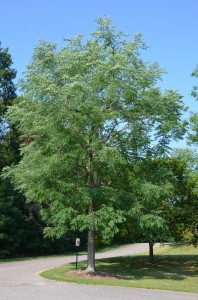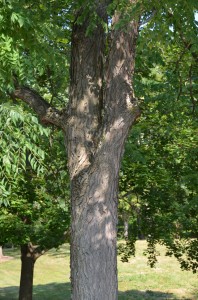Kentucky coffeetree (Gymnocladus dioicus) is a large native tree found in 18 states, from New York west to Nebraska and from central Minnesota south to Oklahoma (zones 4 through 7). It reaches a mature height of 70 feet (some greater than 90 feet) with a spread of 50 feet. Established in 2-3 years, annual growth rate averages 12-15 inches, about the same as ginkgo or white oak.
Late appearing foliage emerges in mid- to late spring. Recessed vegetative buds push forth multi-pinnate compound leaves. A single leaf can be 2 to 3 feet long, producing between 70 and 100 leaflets. Fragrant olive-white flower panicles appear in late May in clusters of 8 to 12 inches long by 3 to 4 inches wide.
In autumn its lime-yellow to golden brown compound foliage falls to become a leaf raker’s nightmare. During the winter months, the totally naked upright branches take on the appearance of an arboreal horror from a Stephen King novel. K-coffeetree may be single or multi-trunked.
K-coffeetree grows in a wide variety of soil types and is tolerant of poorly drained (wet sites). No significant disease or insect pests mar the lush green tropical-like summer foliage. Bark is distinctively charcoal gray and shaggy, a trait more pronounced as the tree ages.
Spring pea-like flowers are dioecious, bearing either male or female flowers. Female trees bear clusters of distinctive bean pods measuring 5 to 10 inches long and 1 ½ to 2 inches wide on the tips of the branches. Flowers and pods are inconspicuous, mostly hidden within the dense foliage through late summer.
‘Espresso’ is a male cultivar with no seed pods to rake up. In colonial America the beans were harvested and a crude coffee extract was brewed, no threat to Folgers® and Maxwell House® today. The leaves and bean seeds are reportedly toxic to man and grazing cattle.
K-coffeetree is rarely sold in garden centers, but available on-line. It is notoriously difficult to transplant, but young 2-inch caliper nursery-grown trees thrive.



 Posted in
Posted in 
